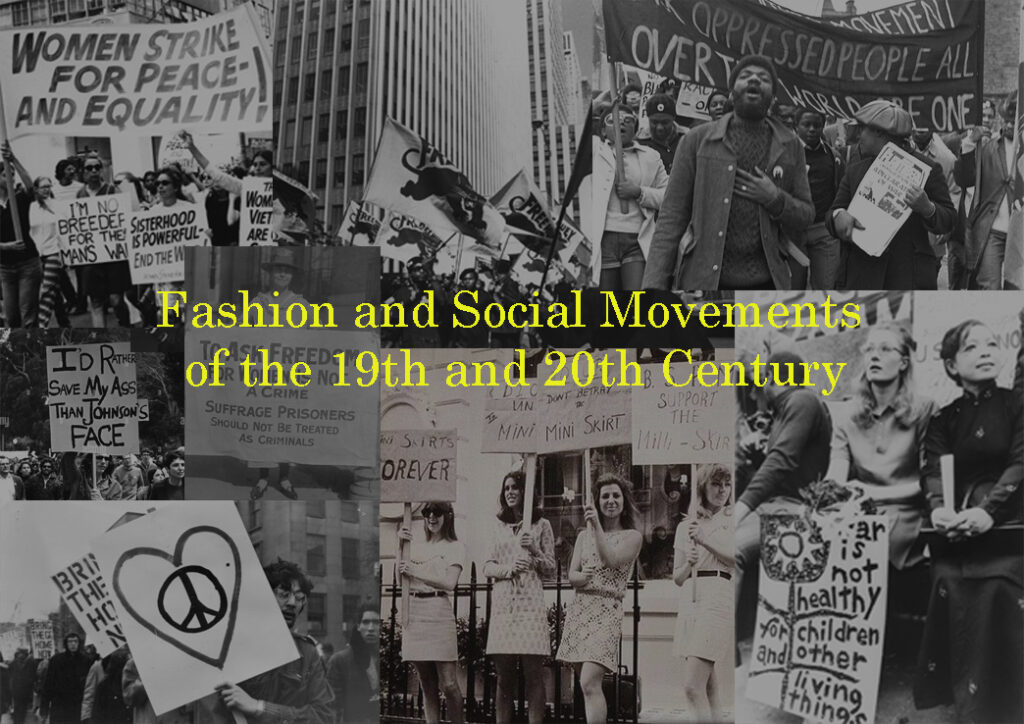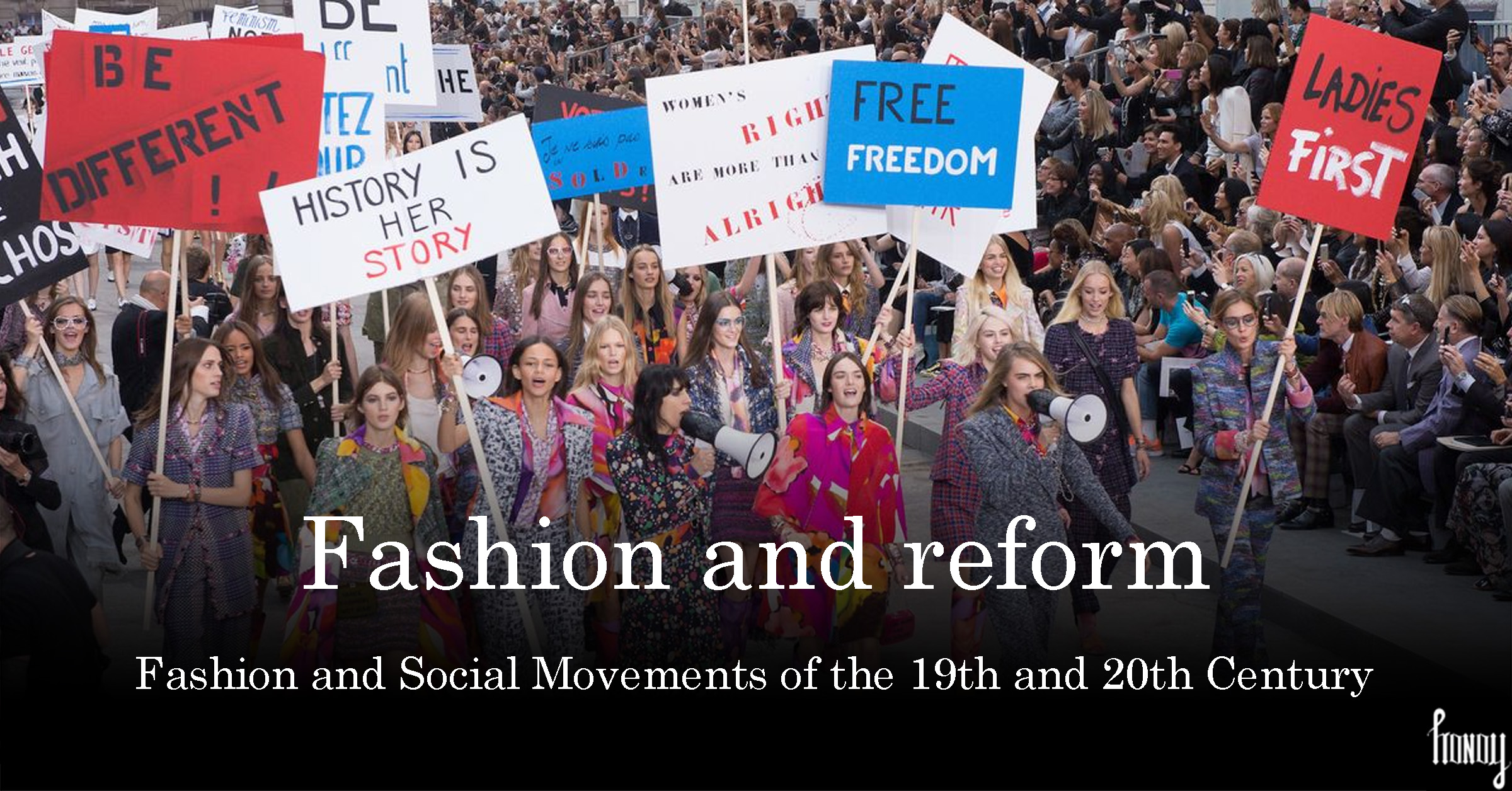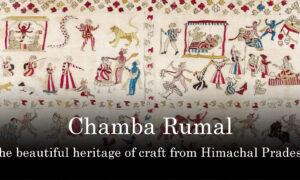Introduction to Fashion & Social Movements
Fashion is more than just clothing; it’s a reflection of society, culture, and values. This blog will explore Fashion & Social Movements of the 19th & 20th Century. Throughout history, fashion has been intertwined with social movements, serving as a powerful tool for self-expression, activism, and cultural change. In the previous centuries there are periods of time marked by significant social upheaval and reform where fashion played a pivotal role in movements advocating for women’s rights, labor rights, civil rights, and anti-colonialism.
Not only that but these movements etched in world history teaches us the importance of clothing and how it affects the society and humanity at large. The following blog on Fashion & Social Movements of the 19th & 20th Century will delve into the fascinating intersection of fashion and social movements during these transformative eras.
Women’s Suffrage Movement (1840-1920)
One of the most prominent social movements of the 19th century was the women’s suffrage movement, which sought to secure voting rights and equal treatment for women. Fashion became a battleground for women’s rights, with activists using clothing as a means of challenging traditional gender roles and asserting their autonomy.
In the early 19th century, women’s clothing was restrictive and impractical, reflecting societal expectations of femininity and domesticity. However, as the suffrage movement gained momentum, women began to embrace more functional and comfortable attire. One notable example is the bloomers, introduced by Amelia Bloomer in the mid-19th century. Bloomers consisted of loose-fitting trousers worn under a knee-length skirt, providing women with greater freedom of movement, and challenging the conventions of proper female dress.
As the suffrage movement progressed, suffragists adopted symbolic colors and accessories to express their solidarity and visibility. In the United States, the suffragists often wore white dresses and sashes in the colors of the movement, such as purple, white, and gold. These colors represented purity, loyalty, and hope for the future, serving as powerful visual symbols of the women’s suffrage cause.
Mini-skirts and the Second-wave Feminist Movement (1960-1980)
Fast-forward to the latter half of the 20th century, and fashion once again became intertwined with feminist activism during the second-wave feminist movement. The mini-skirt, popularized in the 1960s by designers like Mary Quant, became a symbol of women’s liberation and sexual freedom.
The mini-skirt challenged traditional notions of femininity and propriety, offering women the opportunity to embrace their bodies and express their individuality. It represented a rejection of the restrictive clothing norms of previous generations and signaled a shift towards greater gender equality and empowerment.
In addition to the mini-skirt, other fashion trends of the 1960s and 1970s, such as pantsuits, platform shoes, and bold patterns, reflected the changing attitudes towards gender roles and women’s rights. These styles allowed women to assert their independence and agency, both in their personal lives and in the broader social and political landscape.
Industrial Revolution and Fashion (through the 1800s and 1900s)
The Industrial Revolution brought about profound changes in society, economy, and technology, transforming the way goods were produced and consumed. In the realm of fashion, the Industrial Revolution led to the mass production of clothing, making fashionable attire more affordable and accessible to the masses.
With the advent of mechanized textile production and factory-based garment manufacturing, clothing became more standardized and readily available. This democratization of fashion had significant implications for social class dynamics, as individuals from lower socio-economic backgrounds gained access to clothing previously reserved for the elite.
The rise of department stores and mail-order catalogs further contributed to the proliferation of fashion trends and consumer culture. People from all walks of life could now purchase fashionable clothing and accessories, enabling them to participate in the evolving world of fashion.
Fashion History and the Black Panthers Movement (1950-1960)
In the United States, the Civil Rights Movement of the 1950s and 1960s sparked a renewed interest in African American identity and pride. As part of this movement, the Black Panthers emerged as a revolutionary organization advocating for black empowerment and social justice.
Fashion played a significant role in the visual identity of the Black Panthers, with members often sporting distinctive clothing and accessories that reflected their political beliefs and cultural heritage. One iconic fashion statement associated with the Black Panthers was the black leather jacket, which became a symbol of resistance and solidarity.
The Black Panthers also embraced traditional African clothing, such as dashikis and kente cloth, as a means of reclaiming their cultural roots and asserting their identity in a predominantly white society. These garments served as symbols of pride, dignity, and resistance against racial oppression.
Civil Rights, Dignity, And Dashikis (1954 – 1968)

Similarly, in South Africa, the anti-apartheid movement of the 20th century saw fashion used as a form of resistance against racial segregation and discrimination. The African National Congress (ANC) and other anti-apartheid organizations encouraged supporters to wear traditional African attire, such as dashikis, as a symbol of solidarity and defiance.
The dashiki, a loose-fitting tunic adorned with vibrant colors and intricate patterns, became a powerful symbol of African pride and resistance to colonialism. By wearing dashikis, activists sought to reclaim their cultural heritage and challenge the oppressive policies of the apartheid regime.
Hippies and the Anti-Vietnam War Movement (1964–1973)
In the 1960s, the United States was embroiled in the Vietnam War, sparking widespread protests and dissent among the American public. The anti-war movement, fueled by opposition to military intervention and imperialism, gave rise to the countercultural phenomenon known as the hippie movement.
Hippies rejected mainstream society and embraced alternative lifestyles characterized by peace, love, and non-conformity. Their fashion choices reflected their values and beliefs, often incorporating elements of Eastern spirituality, mysticism, and cultural appropriation. The phrase that defined the philosophy of the hippies during this wartime was the “Make love, not war” slogan.
The Protest Logo T-shirt in the Environmental Social Movement (1980s and continuing today)
In recent years, fashion has played a prominent role in environmental activism and sustainability efforts. One example of this is the protest logo T-shirt, which has become a popular means of raising awareness and mobilizing support for environmental causes.
Organizations and grassroots movements advocating for environmental conservation often create T-shirts featuring powerful slogans, symbols, and imagery that highlight pressing environmental issues and call for action. These T-shirts serve as wearable statements of solidarity and activism, allowing individuals to express their support for environmental protection and sustainability.In the 1980s, various celebrities were associated with different social and political movements, but the specific “Protest Logo T-shirt” movement as we know it today did not exist during that time period. The concept of branded protest or activist T-shirts became more prominent in the late 20th and early 21st centuries.
However, during the 1980s, celebrities did participate in various activist movements and wore T-shirts or clothing to show their support for causes such as anti-apartheid, nuclear disarmament, and LGBTQ+ rights. Some celebrities known for their activism during the 1980s were Jane Fonda, Sting, Bono, Madonna, Bob Geldof, Joan Baez, Harry Belafonte, Cyndi Lauper, Bruce Springsteen, Bianca Jagger and many more. These individuals were involved in various social and political causes during the 1980s, although they may not have been specifically associated with a “Protest Logo T-shirt” movement as we understand it today.
Conclusion
From all these examples we can clearly point put that the intersection of history of fashion and social movements in the 19th century illustrates the transformative power of clothing as a tool not just for self-expression but at the same time also for activism, and social change. And these movements have in turn changed and reformed the fashion choices of the world has made thereon.
From the women’s suffrage movement to civil rights struggles and anti-colonial resistance, fashion has served as a medium through which individuals and communities have asserted their identities, challenged oppressive systems, and advocated for justice and equality. By examining the historical context and impact of these fashion movements through this blog we call the Fashion & Social Movements of the 19th and 20th Century , we gain insight into the interconnectedness of style, politics, and culture, and the enduring legacy of fashion as a catalyst for social transformation.





























Pingback: Fashion Magazines - The Best 10 Worldwide